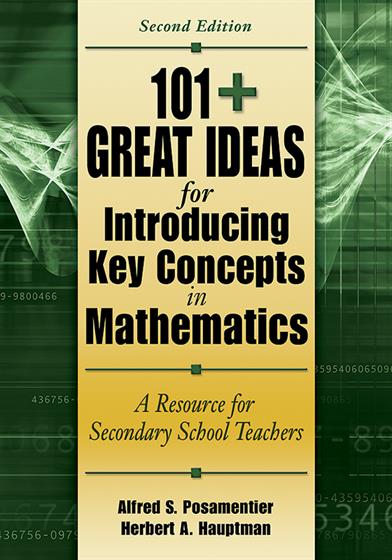Preface
Acknowledgments
About the Authors
Introductory Idea
Coming to Terms With Mathematical Terms
Algebra Ideas
1. Introducing the Product of Two Negatives
2. Multiplying Polynomials by Monomials (Introducing Algebra Tiles)
3. Multiplying Binomials (Using Algebra Tiles)
4. Factoring Trinomials (Using Algebra Tiles)
5. Multiplying Binomials (Geometrically)
6. Factoring Trinomials (Geometrically)
7. Trinomial Factoring
8. How Algebra Can Be Helpful
9. Automatic Factoring of a Trinomial
10. Reasoning Through Algebra
11. Pattern Recognition Cautions
12. Caution With Patterns
13. Using a Parabola as a Calculator
14. Introducing Literal Equations: Simple Algebra to Investigate an Arithmetic Phenomenon
15. Introducing Nonpositive Integer Exponents
16. Importance of Definitions in Mathematics (Algebra)
17. Introduction to Functions
18. When Algebra Explains Arithmetic
19. Sum of an Arithmetic Progression
20. Averaging Rates
21. Using Triangular Numbers to Generate Interesting Relationships
22. Introducing the Solution of Quadratic Equations Through Factoring
23. Rationalizing the Denominator
24. Paper Folding to Generate a Parabola
25. Paper Folding to Generate an Ellipse
26. Paper Folding to Generate a Hyperbola
27. Using Concentric Circles to Generate a Parabola
28. Using Concentric Circles to Generate an Ellipse
29. Using Concentric Circles to Generate a Hyperbola
30. Summing a Series of Powers
31. Sum of Limits
32. Linear Equations With Two Variables
33. Introducing Compound Interest Using the "Rule of 72”
34. Generating Pythagorean Triples
35. Finding Sums of Finite Series Geometry Ideas
Geometry Ideas
1. Sum of the Measures of the Angles of a Triangle
2. Introducing the Sum of the Measures of the Interior Angles of a Polygon
3. Sum of the Measures of the Exterior Angles of a Polygon: I
4. Sum of the Measures of the Exterior Angles of a Polygon: II
5. Triangle Inequality
6. Don’t Necessarily Trust Your Geometric Intuition
7. Importance of Definitions in Mathematics (Geometry)
8. Proving Quadrilaterals to Be Parallelograms
9. Demonstrating the Need to Consider All Information Given
10. Midlines of a Triangle
11. Length of the Median of a Trapezoid
12. Pythagorean Theorem
13. Simple Proofs of the Pythagorean Theorem
14. Angle Measurement With a Circle by Moving the Circle
15. Angle Measurement With a Circle
16. Introducing and Motivating the Measure of an Angle Formed by Two Chords
17. Using the Property of the Opposite Angles of an Inscribed Quadrilateral
18. Introducing the Concept of Slope
19. Introducing Concurrency Through Paper Folding
20. Introducing the Centroid of a Triangle
21. Introducing the Centroid of a Triangle Via a Property
22. Introducing Regular Polygons
23. Introducing Pi
24. The Lunes and the Triangle
25. The Area of a Circle
26. Comparing Areas of Similar Polygons
27. Relating Circles
28. Invariants in Geometry
29. Dynamic Geometry to Find an Optimum Situation
30. Construction-Restricted Circles
31. Avoiding Mistakes in Geometric Proofs
32. Systematic Order in Successive Geometric Moves: Patterns!
33. Introducing the Construction of a Regular Pentagon
34. Euclidean Constructions and the Parabola
35. Euclidean Constructions and the Ellipse
36. Euclidean Constructions and the Hyperbola
37. Constructing Tangents to a Parabola From an External Point P
38. Constructing Tangents to an Ellipse
39. Constructing Tangents to a Hyperbola
Trigonometry Ideas
1. Derivation of the Law of Sines: I
2. Derivation of the Law of Sines: II
3. Derivation of the Law of Sines: III
4. A Simple Derivation for the Sine of the Sum of Two Angles
5. Introductory Excursion to Enable an Alternate Approach to Trigonometry Relationships
6. Using Ptolemy’s Theorem to Develop Trigonometric Identities for Sums and Differences of Angles
7. Introducing the Law of Cosines: I (Using Ptolemy’s Theorem)
8. Introducing the Law of Cosines: II
9. Introducing the Law of Cosines: III
10. Alternate Approach to Introducing Trigonometric Identities
11. Converting to Sines and Cosines
12. Using the Double Angle Formula for the Sine Function
13. Making the Angle Sum Function Meaningful
14. Responding to the Angle-Trisection Question
Probability and Statistics Ideas
1. Introduction of a Sample Space
2. Using Sample Spaces to Solve Tricky Probability Problems
3. Introducing Probability Through Counting (or Probability as Relative Frequency)
4. In Probability You Cannot Always Rely on Your Intuition
5. When “Averages” Are Not Averages: Introducing Weighted Averages
6. The Monty Hall Problem: “Let’s Make a Deal”
7. Conditional Probability in Geometry
8. Introducing the Pascal Triangle
9. Comparing Means Algebraically
10. Comparing Means Geometrically
11. Gambling Can Be Deceptive
Other Topics Ideas
1. Asking the Right Questions
2. Making Arithmetic Means Meaningful
3. Using Place Value to Strengthen Reasoning Ability
4. Prime Numbers
5. Introducing the Concept of Relativity
6. Introduction to Number Theory
7. Extracting a Square Root
8. Introducing Indirect Proof
9. Keeping Differentiation Meaningful
10. Irrationality of the Square Root of an Integer That Is Not a Perfect Square
11. Introduction to the Factorial Function x!
12. Introduction to the Function x to the (n) Power
13. Introduction to the Two Binomial Theorems
14. Factorial Function Revisited
15. Extension of the Factorial Function r! to the Case Where r Is Rational
16. Prime Numbers Revisited
17. Perfect Numbers



